Click on images to enlarge
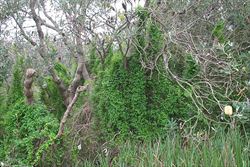
infestation in a banksia woodland (Photo: Jackie Miles and Max Campbell)
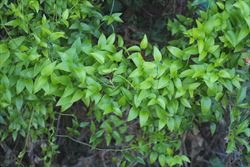
habit (Photo: Trevor James)
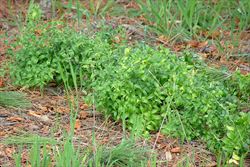
scrambling habit (Photo: Sheldon Navie)
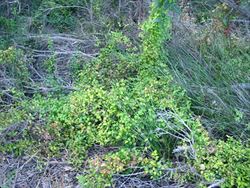
climbing habit (Photo: Sheldon Navie)
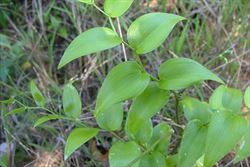
close-up of leaves (Photo: Sheldon Navie)

flowers (Photo: Sheldon Navie)
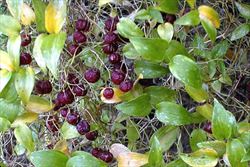
mature fruit (Photo: Jackie Miles and Max Campbell)
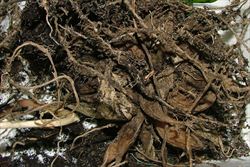
rhizomes, roots and old tubers (Photo: Sheldon Navie)
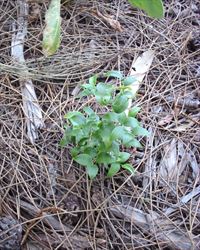
young plant (Photo: Sheldon Navie)
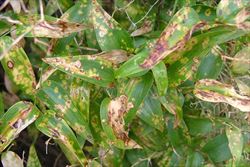
bridal creeper rust damage (Photo: Sheldon Navie)

bluish-green leaves of the "Western Cape form" of this species (Photo: Sheldon Navie)

large tubers of the "Western Cape form" of this species (Photo: Sheldon Navie)
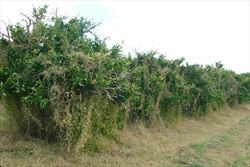
infestation in an orange orchard (Photo: Sheldon Navie)
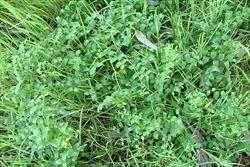
scrambling habit (Photo: Sheldon Navie)
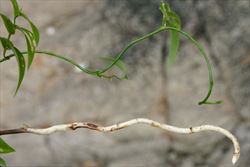
stem and rhizome (Photo: Trevor James)
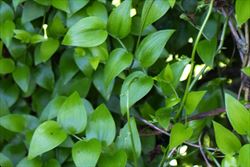
relatively broad 'leaves' (Photo: Trevor James)
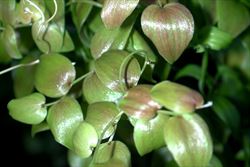
new growth (Photo: Steve Adkins)

close-up of immature fruit (Photo: Sheldon Navie)
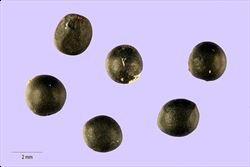
close-up of seeds (Photo: Tracey Slotta at USDA PLANTS Database)
Scientific Name
Asparagus asparagoides (L.) Druce
Synonyms
Asparagus medeoloides (L. f.) Thunb.Asparagus asparagoides (L.) W. WightDracaena medeoloides L. f.Elachanthera sewelliae F. Muell.Luzuriaga sewelliae (F. Muell.) K. KrauseMedeola asparagoides L.Myrsiphyllum asparagoides (L.) Willd.
Family
Asparagaceae (Queensland, New South Wales, the ACT and Western Australia)Liliaceae (Victoria, Tasmania, South Australia and the Northern Territory)
Common Names
African asparagus fern, baby smilax, bridal creeper, bridal veil, bridal veil creeper, florists' smilax, smilax, smilax asparagus
Origin
Native to southern Africa (i.e. Lesotho, South Africa and Swaziland).
Cultivation
Bridal creeper (Asparagus asparagoides) has been widely cultivated as a garden plant, particularly in the temperate regions of southern Australia.
Naturalised Distribution
A very widespread species that is distributed mainly in the southern parts of Australia. Very common in south-western Western Australia, south-eastern South Australia and in much of Victoria. Also scattered in eastern New South Wales and other parts of South Australia, and present in Tasmania and Queensland.
Aslo naturalised in southern Europe, New Zealand, Hawaii and western USA (i.e. California).
Habitat
This species is primarily a weed of temperate regions, but is occasionally also present in semi-arid and cooler sub-tropical environments. It is a weed of open woodlands, closed forests, urban bushland, roadsides, waterways, disturbed sites, waste areas, coastal habitats, orchards and forestry plantations.
Habit
A climbing, scrambling or creeping (i.e. prostrate) herbaceous plant with short-lived (i.e. annual) aboveground growth and long-lived (i.e. perennial) below-ground parts. Most growth occurs during the cooler months of the year and it can reach up to 4 m in height when climbing over other plants. The stems and leaves usually die back during the drier summer months in southern Australia.
Distinguishing Features
- a low-growing creeper or climber with short-lived aboveground stems and long-lived tubers that are produced on creeping underground stems.
- its oval-shaped leathery 'leaves' (10-70 mm long and 4-30 mm wide) are alternately arranged.
- these flattened 'leaves' are glossy in appearance and have several parallel veins.
- its small white or greenish-white flowers (5-10 mm across) have six 'petals' and are borne singly or in pairs in the 'leaf' forks.
- its small round berries (5-10 mm across) turn red as they mature.
Stems and Leaves
The rounded stems are slender, branched, and have a twisted and wiry appearance (about 1-2 mm thick). Large numbers of long-lived tubers are produced along the creeping underground stems (i.e. rhizomes).
The stalkless (i.e. sessile), oval-shaped (i.e. elliptic), 'leaves' are actually modified flattened stems (i.e. cladodes) that have taken over the appearance and function of leaves. These 'leaves' (10-70 mm long and 4-30 mm wide) are flattened, alternately arranged, glossy in appearance, and have several parallel veins. The actual leaves are reduced to small bract-like scales at the base of the cladodes.
Flowers and Fruit
The small drooping flowers (5-10 mm across) are white or greenish-white in colour. They have six 'petals' (i.e. perianth segments or tepals), each about 5 mm long, and six stamens topped with orange or reddish anthers. These flowers are borne individually on short stalks (i.e. pedicels) that emanate from the 'leaf' bases (i.e. axils). The flowers are normally borne singly, but occasionally more than one can be produced in each axil. Flowering usually occurs during winter or early spring, and the fruit mature by early summer.
The mature fruit is a round, sometimes sticky, red berry (5-10 mm in size), however it is green in colour for a long period prior to maturity. Each berry usually contains two or three shiny black seeds (sometimes up to nine seeds may be present) that are egg-shaped (i.e. ovoid) or rounded (i.e. spherical) in shape and about 2-4 mm across.
Reproduction and Dispersal
This plant reproduces by seed and also by underground stems (i.e. rhizomes) and tubers.
The seeds are dispersed by birds and other animals (e.g. rabbits) that eat the fruit, and also by water. Fragments of the creeping underground stems (i.e. rhizomes), tubers and seeds are also spread in dumped garden waste and during soil moving activities.
Environmental Impact
Bridal creeper (Asparagus asparagoides) is regarded as a significant environmental weed in Victoria, South Australia, Tasmania and Western Australia, as a relatively important environmental weed in New South Wales, and as a potential environmental weed in south-eastern Queensland. It is undoubtably one of Australia's most important environmental weeds and is a Weed of National Significance (WoNS).
It is regarded as one of the worst weeds in Australia because of its invasiveness and environmental impacts. Bridal creeper (Asparagus asparagoides) is a major weed of bushland in southern Australia, where its climbing stems and foliage smother native plants and can completely dominate the lower layers of the vegetation. It also forms a dense layer of underground tubers which impedes the root growth of other plants, reduces the soil moisture available to other plants, and prevents seedling establishment. Bridal creeper (Asparagus asparagoides) invades undisturbed bushland habitats and is a major threat to low shrubs and groundcover plants in mallee, dry sclerophyll forest, coastal and heath vegetation. In South Australia and south-western Western Australia bridal creeper is considered to be the most important weed threat to biodiversity and it is actively managed by community groups in these and other regions. In New South Wales it is most common close to the coast, where it invades banksia woodlands and other open coastal vegetation.
Numerous rare and endangered native plants are threatened with extinction by this weed, especially where it has invaded conservation areas. In South Australia it has been identified as a threat to several endangered species, including the pale leek-orchid (Prasophyllum pallidum) in Belair National Park, the west coast mint-bush (Prostanthera calycina) in Calpatanna Waterhole Conservation Park, the sandhill greenhood orchid (Pterostylis arenicola) and the metallic sun-orchid (Thelymitra epipactoides) in Coorong National Park, the blue range emubush (Eremophila barbata) in Hincks Conservation Park, and the ironstone mulla mulla (Ptilotus beckerianus) in Wanilla Conservation Park. It is also thought to be a potential threat to the endangered neat wattle (Acacia rhetinocarpa) on the Yorke Peninsula in South Australia, and the endangered Kangaroo Island pomaderris (Pomaderris halmaturina) on Kangaoo Island. Bridal creeper (Asparagus asparagoides) also smothers existing plants and prevents the regeneration of seedlings of the threatened jumping-Jack wattle (Acacia enterocarpa) in south-eastern South Australia and western Victoria.
In the Coffs Harbour regions in northern New South Wales, the endangered native grass Alexfloydia repens is threatened by several weeds, including bridal creeper (Asparagus asparagoides). This grass is also the sole food plant for the endangered black grass-dart butterfly (Ocybadistes knightorum). So by replacing this butterfly's larval food plant, limiting its regeneration and reducing open space in the overstorey in which adults fly, bridal creeper (Asparagus asparagoides) and other weed species are threatening the survival of two endangered native species in this area. It is also one of the major environmental weeds that are invading the habitat of the endangered rice flower, Pimelea spicata, in the Sydney region in New South Wales.
Other Impacts
Bridal creeper (Asparagus asparagoides) also causes losses to agriculture, especially in the Murray River irrigation area. It is a widespread weed of orchards and forestry plantations. It reduces the productivity of orchards by shading trees (e.g. citrus and avocado trees) and interfering with fruit picking. The short-lived foliage usually dies off during summer, when it may also become a fire hazard.
Legislation
This species is declared under legislation in the following states and territories:
- ACT: C4 - prohibited pest plant (a pest plant whose propagation and supply is prohibited).
- New South Wales: Class 4 - a locally controlled weed. The growth and spread of this species must be controlled according to the measures specified in a management plan published by the local control authority and the plant may not be sold, propagated or knowingly distributed (in the Campbelltown, Hunters Hill, Hornsby, Ku-ring-gai, Lane Cove, Lockhart, Lord Howe Island, Parramatta, Ryde and Willoughby local authority areas), and Class 5 - a restricted weed which must not be sold, bought or knowingly distributed (throughout the entire state).
- Northern Territory: A - to be eradicated (throughout all of the Territory), and C - not to be introduced into the Territory.
- Queensland: Class 1 - introduction into the state is prohibited, and landowners must take reasonable steps to keep land free of this species (throughout the entire state). It is also illegal to sell a declared plant or its seed in this state.
- South Australia: 2@ - this species is a Class 2c weed, and is regarded as a statewide pest plant. Control of this weed must be undertaken (throughout the entire state).
- Tasmania: D - the importation or sale of this species is prohibited and measures to reduce its population in an area, eradicate it from an area, or restrict it to a particular area may be required. Details on actual restrictions or measures for each declared weed are contained in the weed management plan for that species.
- Victoria: R - a restricted weed that poses an unacceptable risk of spread if it were to be sold or traded. It must not be sold, bought or knowingly distributed (throughout the entire state).
- Western Australia: P1 - trade, sale or movement into the state prevented (throughout the entire state).
Management
For information on the management of this species see the following resources:
- Section 2 of the Asparagus Weeds Best Practice Management Manual, which is available online at http://www.weeds.org.au/WoNS/bridalcreeper/docs/Asparagus_Weeds_BPMM-2.pdf.
- the National Weeds Strategy Strategic Plan for this species, which is available online at http://www.weeds.org.au/docs/bcstrat.pdf.
- the Victorian Department of Natural Resources and Environment Landcare Note and Coastal Note on this species, which are available online at http://www.dpi.vic.gov.au.
Similar Species
There is also a second form of bridal creeper (Asparagus asparagoides) present in Australia, which is known as the "Western Cape form". It is slightly larger in stature and restricted to south-eastern South Australia and western Victoria. The two forms can be distinguished by the following differences:
- common bridal creeper has bright green leaves and its fruit have six indistinct lobes. Its tubers are relatively small (2.5-4 cm long) and are found deeper in the soil profile along long horizontal rhizomes.
- the "Western Cape form" of bridal creeper has bluish-green leaves and its fruit have three indistinct lobes. Its tubers are relatively large (4-7.5 cm long) and are found near the soil surface along short vertical rhizomes.
Bridal creeper (Asparagus asparagoides) is somewhat similar to other asparagus ferns (Asparagus spp.), however it can be easily distinguished from them by its larger and broader 'leaves' (10-70 mm long and 10-30 mm wide). It is more often confused with many native vines that have similar leaves, including small-leaved clematis (Clematis microphylla), common apple-berry (Billardiera scandens), the lignums (Muehlenbeckia spp.), wombat berry (Eustrephus latifolius), scrambling lily (Geitonoplesium cymosum) and the native smilax's (Smilax spp.). These species have the following characteristic differences from bridal creeper (Asparagus asparagoides):
- small-leaved clematis (Clematis microphylla) has oppositely arranged compound leaves that have three leaflets.
- common apple-berry (Billardiera scandens) has narrow leaves, flowers with five petals and elongated fruit.
- the lignums (Muehlenbeckia spp.) have stalked (i.e. petiolate) leaves and yellowish flowers with five petals.
- wombat berry (Eustrephus latifolius ) usually has narrow leaves and larger orange fruit (10-20 mm across).
- scrambling lily (Geitonoplesium cymosum) has shortly stalked (i.e. petiolate) leaves and black fruit.
- the native smilax's (Smilax spp.) have flowers borne in dense stalked clusters (i.e. in axillary umbels) and black fruit.

